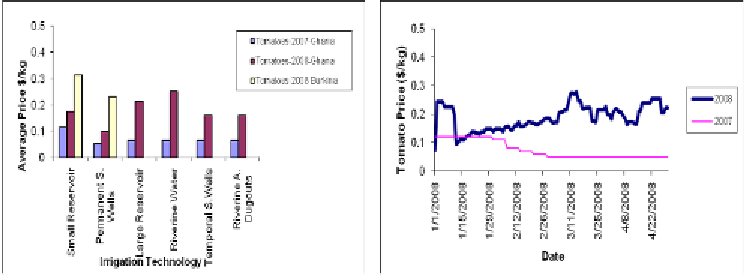Agriculture Reference
In-Depth Information
results of Mdemu (2008) who found that the water productivity of a small
reservoir (Dorongo dam) was higher than that of a large reservoir scheme
(Tono) in the Upper East Region of Ghana. The observed water productivity
for the shallow wells are higher than most published figures and are most
probably due to the high fertilizer application on these fields. For example in
Molden et al. (2007) the fertilizer application ranges from 9kg/ha in sub-
Saharan Africa to 135kg/ha in South-East Asia resulting in a water
productivity for tomatoes ranging from 5-20 kg/m
3
.
Figure 6.5: a) Farm-gate prices for tomatoes in 2007/2008; b) Trend of farm-
gate prices for tomatoes in 2007/2008.
The value of water obtained under tomato cultivation by these irrigation
technologies is estimated using the average market price of tomatoes and
their corresponding water productivities per each technology.
Figure 6.5a
&
b give the recorded on-farm tomato prices for various irrigation technologies
and the average tomato market prices for 2007 and 2008. These figures show
that the market prices are not the same for all irrigation technologies and
that they fluctuate throughout the harvesting season. Also the market prices
of tomatoes depend on the location of the technology. Technologies located
close to the main road attract higher market prices from traders while those
further away from the main road have lower market prices. Those close to
the main road have easy access to traders from southern Ghana while those
further away have difficulty in accessing traders from southern Ghana and
are sometimes compelled to sell to the local market at lower prices.
6.4.3 Economic impact of irrigation technologies
Due to the semi-arid nature of the sub-basin which is characterised by short
rainy seasons coupled with the fact that over 85% of the inhabitants practice
subsistence farming, there are little employment opportunities during the dry
season. This accounts for the high rural-urban migration during the dry
season to do menial jobs in the urban centres. Creating job opportunities for
the inhabitants during the dry season improves local livelihoods and thus
reduces poverty. The additional income made by the farmer and labourer

Search WWH ::

Custom Search